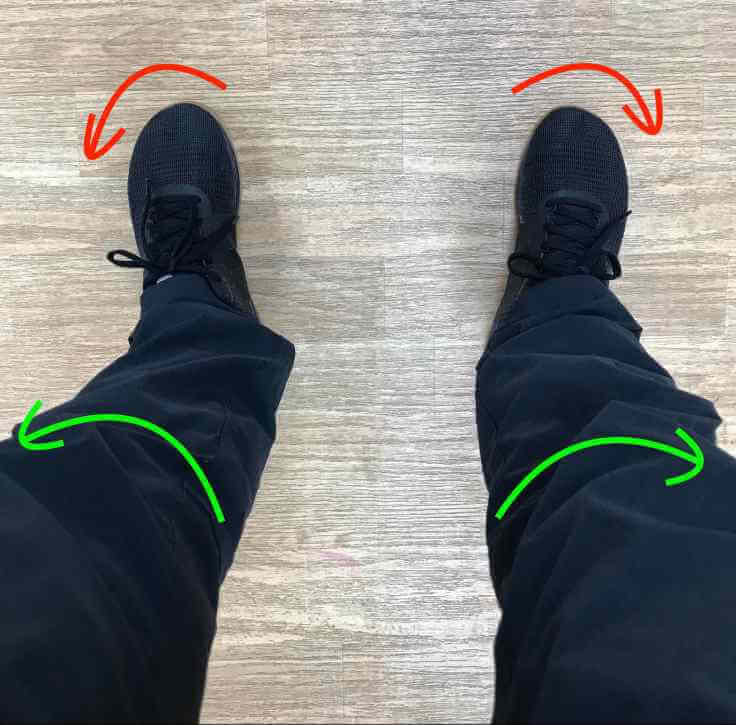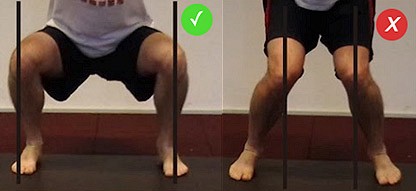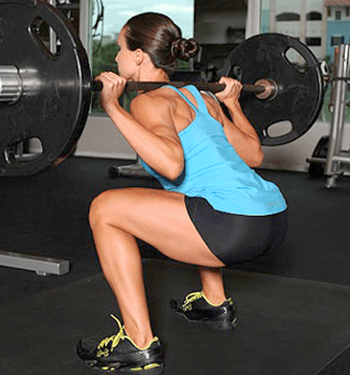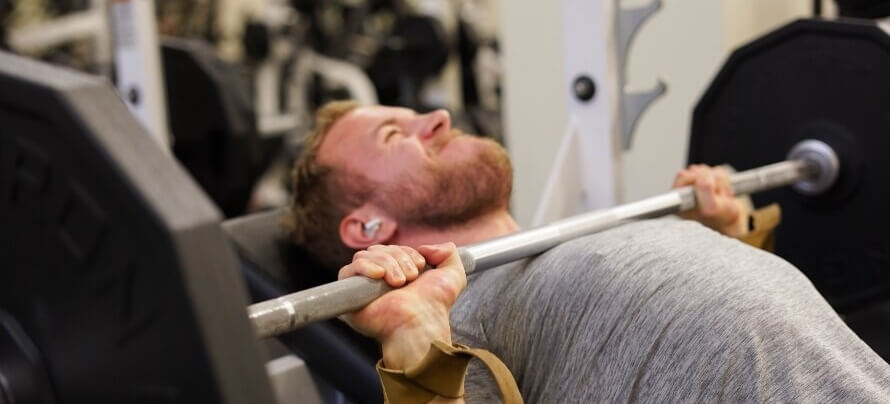Key Takeaways
- A weightlifting cue is a simple reminder, usually in the form of a phrase, that directs your attention to a particular aspect of your exercise technique.
- One of the best bench pressing cues is “break the bar in half,” one of the best cues for squatting is “spread the floor with your feet,” and one of the best cues for deadlifting is “crush oranges in your armpits.”
- Keep reading to learn the rest of the best weightlifting cues for these three exercises, how to use them properly, and why they’re so effective!
Weightlifting may look easy compared to sports like golf, soccer, or gymnastics, but it’s far more technical than most people realize.
For example, properly performing a barbell back squat requires balance, coordination, and strength in a variety of muscle groups. Even the humdrum bench press and deadlift demand meticulous timing and muscular control.
Your weightlifting technique also has a major impact on your long-term fitness results.
In a way, learning proper weightlifting technique is like mastering the fundamentals of personal finance.
“Invest” early by taking the time to hone good weightlifting technique, and that time and effort will pay dividends for the rest of your weightlifting journey.
So, what’s the best way to learn weightlifting technique?
Well, it’s not what most people do, which is aping others in the gym. The fact is that most people who lift weights don’t use good technique, and if you try to mimic what they’re doing, you’ll end up making the same mistakes.
Instead, a better approach is to use what are known as weightlifting cues to learn and improve your technique.
Essentially, a weightlifting cue is just a simple reminder that helps you focus on a particular aspect of your weightlifting technique. For example, the cue “spread the floor with your feet,” is a helpful cue for remembering to keep your knees from caving in while squatting (you’ll learn more about this cue in a moment).
Cues like this may seem obvious, trivial, or boring, but when used properly they can immediately boost your strength, fix seemingly intractable problems with your technique, and significantly reduce your risk of injury.
The bottom line is weightlifting cues are one of the “hacks” you can use to quickly master new exercises and maintain proper technique on ones you’ve already learned.
So, if you want to learn new exercises quickly, get stronger and reduce your risk of injury, keep reading.
Let’s start by taking a closer look at a weightlifting cue actually is.
What Is a Weightlifting Cue?

A weightlifting cue is a simple reminder, usually in the form of a phrase, that directs your attention to a particular aspect of your exercise technique.
Weightlifting cues are most helpful when you’ve already learned the broad strokes of an exercise, and are working to correct certain mistakes or improve specific aspects of your technique.
For instance, if you know the key points of proper bench press technique, but you have a tendency to relax your upper back halfway through your sets, a good cue for correcting this would be “break the bar in half,” which helps maintain tension in your upper back.
If you’re new to weightlifting, check out these tutorials for some of the best exercises you can do:
⇨ The Definitive Guide on How to Bench Press (and the 8 Best Variations!)
⇨ How to Squat: The Definitive Guide (Plus 12 Proven Ways to Improve Your Squat!)
⇨ This Is the Definitive Guide to Proper Deadlift Form
⇨ The Ultimate Guide to the Military Press: The Key to Great Shoulders
⇨ The Definitive Guide to the Barbell Row (and the 8 Best Variations!)
Ideally, a single cue will improve multiple aspects of your technique simultaneously.
For example, a good cue for the barbell back squat is to “keep your chest up,” because if you get this right, it’ll prevent your lower-back from rounding and keep the bar locked in its proper position on your shoulders.
In the case of the barbell bench press, another good cue is to “screw your feet into the floor” because this reminds you to maintain tension in your lower body, which also makes it easier to maintain tension in your upper body.
And in the case of the deadlift, a good cue is to “put your shoulder blades in your back pockets,” because this reminds you to keep your back straight as you stand up with the bar.
I also recommend you pick one weightlifting cue per exercise to focus on at a time.
For instance, if you’re doing a lower-body workout, you could choose to focus on “spreading the floor with your feet” on every rep of the back squat. Once this becomes second nature (usually after a few workouts), you can focus on another cue, like “keep your chest up.”
You can find weightlifting cues for every exercise, and in time, you’ll probably come up with a few of your own.
You’ll also find that many cues that help your technique on one exercise also help your technique on other exercises, too. For example, “break the bar in half” is a helpful cue for both bench pressing and squatting.
Thus, instead of giving you cues for every possible exercise, I’m going to give you three of my favorite cues for the bench press, deadlift, and squat, that also tend to work well for a variety of other exercises.
Summary: A weightlifting cue is a simple reminder, usually in the form of a phrase, that directs your attention to a particular aspect of your exercise technique.
The Best Cues for Bench Pressing
The bench press is one of the best exercises for increasing your upper body strength and size. It trains your chest, triceps, and shoulders, and your forearms, biceps, and traps to a lesser degree.
Read: The Definitive Guide on How to Bench Press (and the 8 Best Variations!)
Before we look at the best cues for bench pressing, watch the first few seconds of this video to see what good bench press technique looks like:
Pay particular attention to these aspects of his technique:
- His shoulder blades are pulled “back and down” and he never loses that tension during any part of the movement.
- His elbows stay about a foot away from his torso and aren’t too flared out to the sides or too close to his chest.
- His wrists are just slightly flexed, but not folded over backwards toward his head.
- He has a gentle arch in his lower back.
- His butt stays firmly planted on the bench during every rep.
- His feet are about shoulder-width apart and remain firmly in place during every rep (no wiggling from side to side).
The biggest bench press mistakes are the opposite of the list you just learned:
- Letting your shoulder blades slide out of position.
- Flaring your elbows out to the side or keeping them tight against your chest.
- Letting your wrists bend back toward your face.
- Not arching your lower-back or arching it so much that it causes your butt to come off the bench.
- Moving your feet or rising up onto your tippy toes.
That’s a lot to keep in mind.
Luckily, you can avoid most of these problems with just a handful of cues. If you use these cues consistently, most of the other elements of your form will usually fall into place.
Here they are:
“Break the bar in half.”
Think about squeezing the bar as hard as possible, as if you’re trying to bend it in half.
The goal of this cue is to maintain tension in your upper body, which keeps your shoulder blades pulled “back and down” and stabilizes your entire torso. As you learned a moment ago, letting your shoulder blades slide out of position is one of the most common mistakes when bench pressing.
Watch the first few seconds of this video for a good description of what this looks and feels like:
This cue is also helpful for all kinds of bench press variations like the close-, wide-, and reverse-grip bench press.
“Screw your feet into the floor.”
Think about pushing your feet into the ground and twisting them out to the side at the same time, as if you were trying to “screw” them into the ground.
Although you’ll want to position your feet wider than this while bench pressing, here’s the general mental image you should have in mind:

The idea here is to maintain lower body tightness, which is another issue many people struggle with when bench pressing. Although your upper body does most of the work, your legs stabilize your torso, which helps you maintain your balance and thus press more weight than you’d be able to otherwise.
This cue works whether you like to position your feet flat on the floor or stay up on your tippy toes. Either way, you want to think about “drilling” or “screwing” your feet/toes into the floor to create tension in your lower body.
Your thighs, glutes, and lower-back should all feel tight when you do this.
“Don’t crack the egg.”
Imagine there’s an egg resting on your sternum, and think about lowering the bar until it touches the egg without breaking it, before driving it upward.
The goal of this cue is to remind you not to lower the bar too fast or bounce it off your chest, which not only reduces the effectiveness of the exercise but can also increase your risk of injury.
Here’s what you’re going for:
Of course, if this guy really did have an egg on his chest it would break, but the idea is just to remind yourself to control the speed at which you lower the bar (not necessarily to lower it as slowly and gently as possible).
Notice how the bar isn’t bouncing off his chest or sinking into it. Instead, he has complete control of the bar at all times, taps it on his chest, then presses it straight up. That’s what you want.
The Best Cues for Squatting
Whether you want bigger quads, hamstrings, glutes, or calves, squats will get the job done.
Read: How to Squat: The Definitive Guide (Plus 12 Proven Ways to Improve Your Squat!)
They’re also one of the most difficult exercises to do correctly, though, which is why it’s particularly important to use effective cues when squatting.
Before we look at the best squat cues, let’s quickly review what proper squat form looks like.
Watch the first few seconds of this video to see what you’re aiming for:
Notice how …
- He moves the bar more or less straight up and down.
- His spine remains straight and his chest stays up, even as he leans over (no bending forward or backward).
- His knees move straight out toward and over his toes (and don’t collapse inward).
- His hips rise at the same rate as his shoulders.
- He maintains a strong grip on the bar.
- His feet stay firmly planted on the ground (no rising onto his tippy toes or leaning back on his heels).
In other words, he has more or less perfect squat form.
So, what are the biggest squatting mistakes people make? Well, once again list is more or less the reverse of the one you just learned:
- Letting the bar drift forward or backward as you sit down and stand up.
- Letting your back bend forward or backward.
- Letting your knees cave in toward one another.
- Letting your hips shoot up faster than their shoulders.
- Relaxing your grip on the bar.
- Moving your feet.
So, what are the best cues for ingraining proper squat technique and avoiding these mistakes?
Here are my favorites:
“Spread the floor with your feet.”
Without moving your feet, think about pushing the floor apart by driving your feet into the ground and away from each other while squatting.
The goal of this cue is to prevent your knees from collapsing inward, like this, which reduces how much you can lift and can irritate your joints over time:

This is a good cue to keep in mind during any portion of the squat, but it’s particularly important to remember when standing up, which is when most people allow their knees to cave in toward one another.
This cue also helps improve your form on squat variations like the barbell front squat, safety bar squat, and goblet squat.
“Keep your chest up.”
Think about pushing your chest muscles up and out and your shoulders back, as if you were trying to maintain perfect “military” posture.
Your upper body should look like this throughout the entire exercise:
See how the logo on his shirt is facing forward the entire time? That’s what you want.
In fact, another helpful cue that’s similar to this one is to “show your logo.” That is, you want to imagine you’re showing the logo on the front of your shirt to someone standing in front of you while squatting.
One of the biggest mistakes people make when squatting is letting their upper back relax, especially when they begin to stand up, and this causes just about every other part of their squat technique to fall apart, too.
Here’s an extreme version of what this looks like:

When you relax your upper back, your shoulders also relax … which allows the bar to shift out of its proper position … which forces you to move your torso to maintain your balance … which forces your knees and hips out of their proper position … you get the idea.
If you keep your chest up, though, you can avoid these problems.
“Explode out of the hole.”
Think about driving the bar upward as quickly as possible and driving your feet into the floor as hard as possible at the same time.
This cue is a little different from the other two, in that instead of reminding you to focus on a technical aspect of the exercise, it’s a general recommendation of how to perform the exercise.
“The hole” refers to the bottommost position of the squat, which looks like this for most people:

The most difficult part of the squat is when your hips are about 6 to 12 inches higher than they are when you’re “in the hole.”
When you reach this point, often referred to as “the sticking point,” it’s easy to let some aspects of your form falter. For example, this is the point when many people let their knees cave inward, or allow their upper back to relax, or let the bar tilt to one side, and so forth.
You can reduce the chances of this happening by getting out of the hole and standing up as quickly as possible, which is why it’s helpful to think about “exploding out of the hole.”
In other words, exploding out of the hole helps you build momentum as you begin standing up, which helps you get through the sticking point faster, which reduces the chances of your technique falling apart.
The Best Cues for Deadlifting
If you had to pick one exercise to do for the rest of your life, it should probably be the deadlift.
Mark Rippetoe said it best in an article he published here on Legion:
The deadlift works just about every muscle group you want to develop, from your upper-back muscles down to your calves, and it forces you to get strong the right way, with the bar in your hands balanced on your feet.
If you want to look strong, you have to get strong. And strong you’ll get from the deadlift.
And I agree.
The deadlift may look simple—just pick the bar up and put it down—but it’s still easy to leave gains on the table or hurt yourself if you make just one or two small mistakes. Thus, weightlifting cues are extremely helpful for learning and practicing proper deadlift form and getting the most out of this remarkable exercise.
Here’s what proper deadlift form looks like:
Notice how …
- The bar moves in a more or less perfectly straight line up and down over his mid-foot.
- The bar slides up his shins and thighs on the way up and on the way down (no drifting forward).
- His back stays straight and his shoulder blades remain “down and back” throughout each repetition of the exercise.
- He maintains control of the bar as he lowers it, but the entire descent doesn’t take more than a second.
- He takes a moment to reset after each repetition.
That’s what a picture-perfect deadlift looks like. Bad deadlift technique looks something like this …
- Letting the bar drift forward over your toes.
- Rounding your middle- and lower-back and relaxing your shoulder blades.
- Hyperextending your back or leaning backward after standing up straight.
- Dropping the bar to the floor after each rep or bouncing the weight off the ground without resetting.
Alright, now let’s cover the best cues for avoiding these mistakes.
“Crush oranges in your armpits.”
For me, this has been the single most effective cue for improving my deadlift technique.
Imagine there’s an orange wedged under each of your armpits, and you’re trying to squeeze the juice out of both of them.
This cue does a number of things for you:
- It ensures your shoulders are in the right starting position, which helps you lift more weight and maintain consistent form from one repetition to the next.
- It helps prevent your upper-back from rounding (which reduces the likelihood of your lower-back rounding).
- It helps you get your entire body into the proper position before you pull, which helps you lift more weight.
Here’s a video that helps explain how your shoulders should be positioned before you start each rep:
As explained in the video, if your shoulders are pinched together or shrugged up, they’ll get pulled down and forward during the deadlift, which can throw off your balance and force you to change your posture mid-rep, which wastes energy and increases the risk of injury.
If you start each rep with your shoulders in the correct position, though, they shouldn’t move at all as you pull the bar upward.
“Push your butt back.”
After you’ve got your feet in the correct position and you’ve grabbed hold of the bar, think about pushing your butt out and back behind you.
This does two important things:
- It helps flatten your back, which reduces your risk of injury and helps you lift more weight.
- It ensures your hips are at the appropriate height when you begin each repetition, which saves energy and thus helps you lift more weight.
Here’s what this looks like:
Many people, especially those new to deadlifting, struggle to keep their backs from rounding as they stand up. Pushing your butt back is one of the simplest and easiest ways to fix this problem.
Another common mistake is setting up for the deadlift with your hips too low, which looks like this:
Instead, you want to set up with your hips as high as you comfortably can, so that your hips and back rise at roughly the same rate as you pull the weight.
“Drag the bar up your legs.”
Think about dragging the bar up your shins, over your knees, and up your thighs until you’re standing up straight.
The barbell should remain in contact with the front of your legs or nearly so throughout the entire repetition, like this:
One of the most common mistakes people make when deadlifting is letting the bar drift forward several inches in front of their shins, which wastes energy and increases the likelihood of rounding their back.
Keeping the bar as close to the front of your legs as possible solves this problem, reducing the distance the bar has to travel and making it easier to maintain a straight back.
(If you have a gory imagination, like me, you can also pretend that the bar is a giant vegetable peeler, and you’re trying to shave the skin off the front of your legs. Gross, but hard to forget!)
The Bottom Line on the Best Weightlifting Cues

A weightlifting cue is just a short phrase or command that helps you keep your form in while performing an exercise.
Some of my favorite weightlifting cues for the bench press, squat, and deadlift are as follows.
Bench press:
- “Break the bar in half.” (Reminds you to maintain tension in your upper body).
- “Screw your feet into the floor.” (Reminds you to maintain tension in your lower body).
- “Don’t crack the egg.” (Reminds you to gently touch the bar to your chest).
Squat:
- “Spread the floor with your feet.” (Reminds you to keep your knees from collapsing in toward one another).
- “Keep your chest up.” (Reminds you to maintain upper body tension and a straight back).
- “Explode out of the hole.” (Reminds you to drive your feet into the ground to get through the hardest part of the exercise as quickly as possible).
Deadlift:
- “Crush oranges in your armpits.” (Reminds you to maintain tension in your upper back and shoulders).
- “Push your butt back.” (Reminds you to maintain a flat back and to start each rep with your hips at an appropriate height).
- “Drag the bar up your legs.” (Reminds you to keep the bar over your midfoot and close to your legs).
Decide what aspect of your technique you’d like to improve the most for each of these exercises, pick a cue that addresses that part of your technique, and focus on that cue every time you perform that exercise for the next one to two months.
If you’re like most people, your technique, strength, and confidence while lifting will immediately improve.










